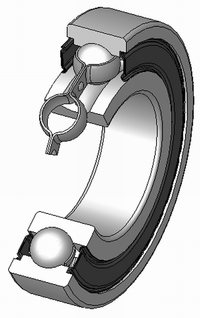
Photo from wikipedia
The gearwheel encoder with a magnetoresistive (MR) sensor is robust, simple, and widely used in high-speed industrial motor drives. Moreover, a high-precision rotor position detection is possible with the gearwheel… Click to show full abstract
The gearwheel encoder with a magnetoresistive (MR) sensor is robust, simple, and widely used in high-speed industrial motor drives. Moreover, a high-precision rotor position detection is possible with the gearwheel encoder due to its large number of output pulses per revolution. The MR sensor outputs two sinusoidal signals that are 90 degrees apart, the period of which matches with one tooth of the gearwheel. However, these output signals are not perfectly sinusoidal because the MR sensor is manually mounted, and the magnitudes of these signals depend on the distance between the MR material and gearwheel. This slight imperfection in the output signals provokes large speed ripples in the speed measurement. This study analyzed the speed measurement ripples, and an effective ripple-elimination method was devised based on the results of the analysis. Ripple components caused by each signal error were calculated from the error signal models, and exact ripple frequencies were extracted. From the calculation results, a frequency adaptive series notch filter algorithm was designed. The simulation and experimental results demonstrated the effectiveness of the analysis and proposed approach. It is obviously shown through the experimental results that the speed measurement ripple is almost eliminated with the proposed method, and, thus, the analysis is valid.
Journal Title: IEEE Transactions on Industrial Electronics
Year Published: 2023
Link to full text (if available)
Share on Social Media: Sign Up to like & get
recommendations!